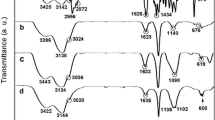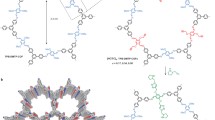Abstract
This study reports the first strategy for establishing chiral 3D porous hybrid foams constructed by optically active helical-substituted polyacetylene and reduced graphene oxide (RGO). Firstly, RGO-foam was prepared from graphene oxide through a reduction/self-assembly process, and then adsorbed monomer, cross-linking agent, and catalyst. After polymerization, cross-linked helical polymer chains formed inside the RGO-foam, providing chiral 3D foams. Circular dichroism spectra verified the formation of helical polymer chains with preferential helicity and considerable optical activity of the chiral 3D foams. Their porous structure was observed by SEM. TGA and BET analyses demonstrated the foams’ remarkable thermostability and high specific surface area. The chiral foams were used as additive to induce enantioselective crystallization of racemic alanine. l-Alanine was preferentially induced to form needle-like crystals. The chiral foams could be easily separated and reused. This study provides a novel type of chiral hybrid materials with significant potential applications in chiral-related areas.








Similar content being viewed by others
References
Zhu Y, Murali S, Cai W, Li X, Suk JW, Potts JR, Ruoff RS (2010) Graphene and graphene oxide: synthesis, properties, and applications. Adv Mater 22:3906–3924
Georgakilas V, Tiwari JN, Kemp KC, Perman JA, Bourlinos AB, Kim KS, Zboril R (2016) Noncovalent functionalization of graphene and graphene oxide for energy materials, biosensing, catalytic, and biomedical applications. Chem Rev 116:5464–5519
Raccichini R, Varzi A, Passerini S, Scrosati B (2015) The role of graphene for electrochemical energy storage. Nat Mater 14:271–279
Ambrosi A, Chua CK, Bonanni A, Pumera M (2014) Electrochemistry of graphene and related materials. Chem Rev 114:7150–7188
Koppens FHL, Mueller T, Avouris P, Ferrari AC, Vitiello MS, Polini M (2014) Photodetectors based on graphene, other two-dimensional materials and hybrid systems. Nat Nanotechnol 9:780–793
Johnson DW, Dobson BP, Coleman KSA (2015) Manufacturing perspective on graphene dispersions. Curr Opin Colloid Interface Sci 20:367–382
Tang L-C, Wan Y-J, Yan D, Pei Y-B, Zhao L, Li Y-B, Wu L-B, Jiang J-X, Lai G-Q (2013) The Effect of graphene dispersion on the mechanical properties of graphene/epoxy composites. Carbon 60:16–27
Lee JH, Park N, Kim BG, Jung DS, Im K, Hur J, Choi JW (2013) Restacking-inhibited 3D reduced graphene oxide for high performance supercapacitor electrodes. ACS Nano 7:9366–9374
Wan Y-J, Tang L-C, Gong L-X, Yan D, Li Y-B, Wu L-B, Jiang J-X, Lai G-Q (2014) Grafting of epoxy chains onto graphene oxide for epoxy composites with improved mechanical and thermal properties. Carbon 69:467–480
Ni Y, Chen L, Teng K, Shi J, Qian X, Xu Z, Tian X, Hu C, Ma M (2015) Superior mechanical properties of epoxy composites reinforced by 3D interconnected graphene skeleton. ACS Appl Mater Interfaces 7:11583–11591
Chen W, Yan L (2011) In situ self-assembly of mild chemical reduction graphene for three-dimensional architectures. Nanoscale 3:3132–3137
Ji H, Zhang L, Pettes MT, Li H, Chen S, Shi L, Piner R, Ruoff RS (2012) Ultrathin graphite foam: a three-dimensional conductive network for battery electrodes. Nano Lett 12:2446–2451
Qiu L, Liu JZ, Chang SLY, Wu Y, Li D (2012) Biomimetic superelastic graphene-based cellular monoliths. Nat Commun 3:1241
Chen Z, Ren W, Gao L, Liu B, Pei S, Cheng H-M (2011) Three-dimensional flexible and conductive interconnected graphene networks grown by chemical vapour deposition. Nat Mater 10:424–428
Xu Y, Sheng K, Li C, Shi G (2010) Self-assembled graphene hydrogel via a one-step hydrothermal process. ACS Nano 4:4324–4330
Jia J, Sun X, Lin X, Shen X, Mai Y-W, Kim J-K (2014) Exceptional electrical conductivity and fracture resistance of 3D interconnected graphene foam/epoxy composites. ACS Nano 8:5774–5783
Chen Z, Xu C, Ma C, Ren W, Cheng H-M (2013) Lightweight and flexible graphene foam composites for high-performance electromagnetic interference shielding. Adv Mater 25:1296–1300
Samad YA, Li Y, Alhassan SM, Liao K (2015) Novel graphene foam composite with adjustable sensitivity for sensor applications. ACS Appl Mater Interfaces 7:9195–9202
Li Y, Pei X, Shen B, Zhai W, Zhang L, Zheng W (2015) Polyimide/graphene composite foam sheets with ultrahigh thermostability for electromagnetic interference shielding. RSC Adv 5:24342–24351
Sun H, She P, Xu K, Shang Y, Yin S, Liu Z (2015) A self-standing nanocomposite foam of polyaniline@ reduced graphene oxide for flexible super-capacitors. Synth Met 209:68–73
Gopalaiah K (2013) Chiral iron catalysts for asymmetric synthesis. Chem Rev 113:3248–3296
Zhang X, Yin J, Yoon J (2014) Recent advances in development of chiral fluorescent and colorimetric sensors. Chem Rev 114:4918–4959
Van de Voorde B, Bueken B, Denayer J, De Vos D (2014) Adsorptive separation on metal–organic frameworks in the liquid phase. Chem Soc Rev 43:5766–5788
Brimioulle R, Lenhart D, Maturi MM, Bach T (2015) Enantioselective catalysis of photochemical reactions. Angew Chem Int Ed 54:3872–3890
Guerra S, Iehl J, Holler M, Peterca M, Wilson DA, Partridge BE, Zhang S, Deschenaux R, Nierengarten J-F, Percec V (2015) Self-organisation of dodeca-dendronized fullerene into supramolecular discs and helical columns containing a nanowire-like core. Chem Sci 6:3393–3401
Kim H, Seo K-U, Jin Y-J, Lee C-L, Teraguchi M, Kaneko T, Aoki T, Kwak G (2016) Highly emissive, optically active poly (diphenylacetylene) having a bulky chiral side group. ACS Macro Lett 5:622–625
Chu G, Wang X, Yin H, Shi Y, Jiang H, Chen T, Gao J, Qu D, Xu Y, Ding D (2015) Free-standing optically switchable chiral plasmonic photonic crystal based on self-assembled cellulose nanorods and gold nanoparticles. ACS Appl Mater Interfaces 7:21797–21806
Huang H, Ren C, Yu C, Yang W, Deng J (2014) Cholic acid/graphene oxide chiral hybrid material: preparation and characterizations. Acta Chim Sin 72:1169–1174
Gellman AJ (2010) Chiral surfaces: accomplishments and challenges. ACS Nano 4:5–10
Helmich F, Lee CC, Schenning APHJ, Meijer EW (2010) Chiral memory via chiral amplification and selective depolymerization of porphyrin aggregates. J Am Chem Soc 132:16753–16755
Green MM, Park J-W, Sato T, Teramoto A, Lifson S, Selinger RLB, Selinger JV (1999) The macromolecular route to chiral amplification. Angew Chem Int Ed 38:3138–3154
Budhathoki-Uprety J, Novak BM (2011) Synthesis of alkyne-functionalized helical polycarbodiimides and their ligation to small molecules using ‘click’ and sonogashira reactions. Macromolecules 44:5947–5954
Freire F, Quiñoá E, Riguera R (2016) Supramolecular assemblies from poly(phenylacetylene)s. Chem Rev 116:1242–1271
Huang H, Deng J, Shi Y (2016) Optically active physical gels with chiral memory ability: directly prepared by helix-sense-selective polymerization. Macromolecules 49:2948–2956
Liu J, Lam JWY, Tang BZ (2009) Acetylenic polymers: syntheses, structures, and functions. Chem Rev 109:5799–5867
Yu Z-P, Ma C-H, Wang Q, Liu N, Yin J, Wu Z-Q (2016) Polyallene-block-polythiophene-block-polyallene copolymers: one-pot synthesis, helical assembly, and multiresponsiveness. Macromolecules 49:1180–1190
Shiotsuki M, Sanda F, Masuda T (2011) Polymerization of substituted acetylenes and features of the formed polymers. Polym Chem 2:1044–1058
Zhang C, Wang H, Geng Q, Yang T, Liu L, Sakai R, Satoh T, Kakuchi T, Okamoto Y (2013) Synthesis of helical poly (phenylacetylene)s with amide linkage bearing l-phenylalanine and l-phenylglycine ethyl ester pendants and their applications as chiral stationary phases for HPLC. Macromolecules 46:8406–8415
Yashima E, Maeda K, Iida H, Furusho Y, Nagai K (2009) Helical polymers: synthesis, structures, and functions. Chem Rev 109:6102–6211
ter Huurne GM, Gillissen MAJ, Palmans ARA, Voets IK, Meijer EW (2015) The coil-to-globule transition of single-chain polymeric nanoparticles with a chiral internal secondary structure. Macromolecules 48:3949–3956
Zhang H, Yang W, Deng J (2015) Fabrication of optically active microparticles constructed by helical polymer/quinine and their application to asymmetric michael addition. Polymer 80:115–122
Ke Y-Z, Nagata Y, Yamada T, Suginome M (2015) Majority-rules-type helical poly(quinoxaline-2,3-diyl)s as highly efficient chirality-amplification systems for asymmetric catalysis. Angew Chem Int Ed 54:9333–9337
Anger E, Iida H, Yamaguchi T, Hayashi K, Kumano D, Crassous J, Vanthuyne N, Roussel C, Yashima E (2014) Synthesis and chiral recognition ability of helical polyacetylenes bearing helicene pendants. Polym Chem 5:4909–4914
Liang J, Song C, Deng J (2014) Optically active microspheres constructed by helical substituted polyacetylene and used for adsorption of organic compounds in aqueous systems. ACS Appl Mater Interfaces 6:19041–19049
Liang J, Wu Y, Deng J (2016) Construction of molecularly imprinted polymer microspheres by using helical substituted polyacetylene and application in enantio-differentiating release and adsorption. ACS Appl Mater Interfaces 8:12494–12503
Chen C, Zhao B, Deng J (2015) Optically active porous microspheres consisting of helical substituted polyacetylene prepared by precipitation polymerization without porogen and the application in enantioselective crystallization. ACS Macro Lett 4:348–352
Preiss LC, Werber L, Fischer V, Hanif S, Landfester K, Mastai Y, Muñoz-Espí R (2015) Amino-acid-based chiral nanoparticles for enantioselective crystallization. Adv Mater 27:2728–2732
Li W, Liu X, Qian G, Deng J (2014) Immobilization of optically active helical polyacetylene-derived nanoparticles on graphene oxide by chemical bonds and their use in enantioselective crystallization. Chem Mater 26:1948–1956
Ren C, Chen Y, Zhang H, Deng J (2013) Noncovalent chiral functionalization of graphene with optically active helical polymers. Macromol Rapid Commun 34:1368–1374
Hummers WSJ, Offeman RE (1958) Preparation of graphitic oxide. J Am Chem Soc 80:1339
Sing KSW, Everett DH, Haul RAW, Moscou L, Pierotti RA, Rouquérol J, Siemieniewska T (1985) Reporting physisorption data for gas/solid systems with special reference to the determination of surface area and porosity. Pure Appl Chem 57:603–619
Saito K, Nakamura J, Natori A (2007) Ballistic thermal conductance of a graphene sheet. Phys Rev B 76:115409
Balandin AA, Ghosh S, Bao W, Calizo I, Teweldebrhan D, Miao F, Lau CN (2008) Superior thermal conductivity of single-layer graphene. Nano Lett 8:902–907
Liu D, Chen H, Deng J, Yang W (2013) Optically active, magnetic gels consisting of helical substituted polyacetylene and Fe3O4 nanoparticles: preparation and chiral recognition ability. J Mater Chem C 1:8066–8074
Song C, Zhang C, Wang F, Yang W, Deng J (2013) Chiral polymeric microspheres grafted with optically active helical polymer chains: a new class of materials for chiral recognition and chirally controlled release. Polym Chem 4:645–652
Liang J, Wu Y, Deng X, Deng J (2015) Optically active porous materials constructed by chirally helical substituted polyacetylene through a high internal phase emulsion approach and the application in enantioselective crystallization. ACS Macro Lett 4:1179–1183
Acknowledgement
This work was supported by the National Natural Science Foundation of China (21474007, 21274008) and the Funds for Creative Research Groups of China (51521062).
Author information
Authors and Affiliations
Corresponding author
Ethics declarations
Conflict of interest
The authors declare no competing financial interest.
Electronic supplementary material
Below is the link to the electronic supplementary material.
10853_2016_702_MOESM1_ESM.doc
Supporting Information Materials and measurements, supplementary data (XRD patterns, FT-IR and CD spectra), XRD patterns analysis, FT-IR spectra analysis. (DOC 139 kb)
Rights and permissions
About this article
Cite this article
Wang, B., Li, W. & Deng, J. Chiral 3D porous hybrid foams constructed by graphene and helically substituted polyacetylene: preparation and application in enantioselective crystallization. J Mater Sci 52, 4575–4586 (2017). https://doi.org/10.1007/s10853-016-0702-1
Received:
Accepted:
Published:
Issue Date:
DOI: https://doi.org/10.1007/s10853-016-0702-1




